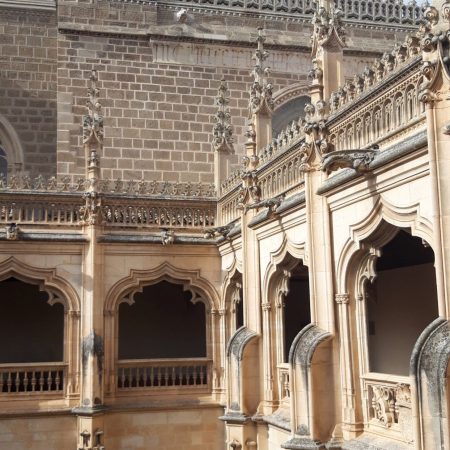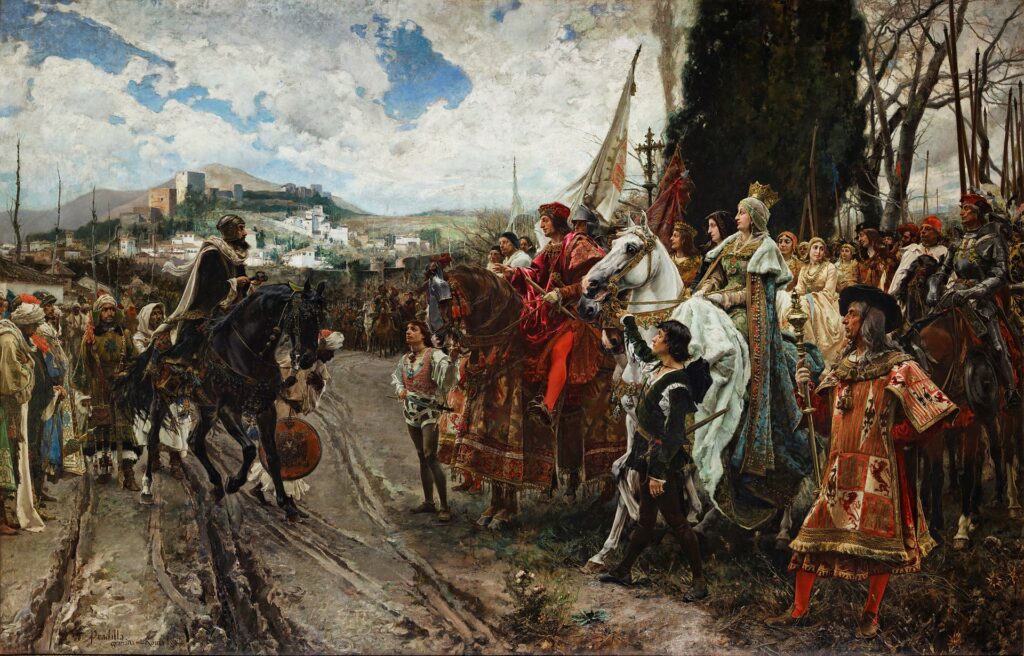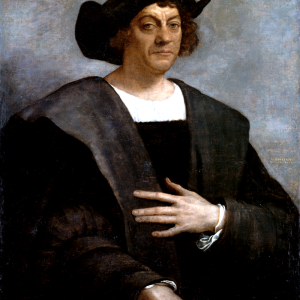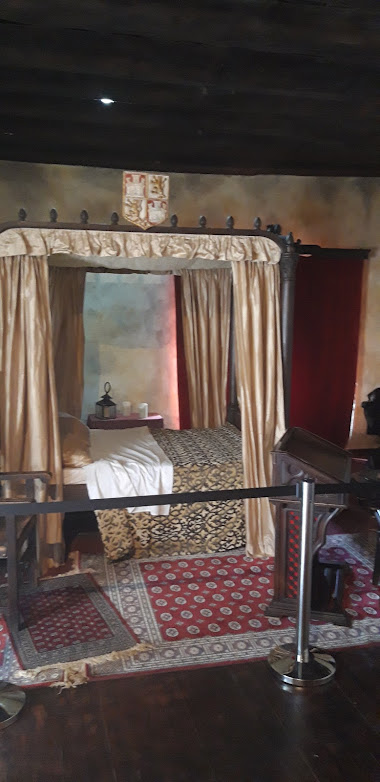Life of Isabel in a Nutshell
Her biographer Hernando de Pulgar characterized her in this way: average height, well composed in her person and the proportion of her limbs, very white and blonde, eyes between green and blue, expression gracious and honest, physiognomy well located, her face beautiful and amiable, very inclined to do good, She had a strong inclination toward justice. By nature, she was right-minded and inclined to indignation. People did everything possible to avoid provoking her anger.
Isabel was born on April 22, 1451, in Madrigal de las Altas Torres, a small town in present-day Castile and León, in the province of Ávila, about 150 kilometers northwest of Madrid.
After the death of her father, Juan II of Castile, in 1454, Isabel, who was only three years old at the time, moved with her mother and her younger brother Alfonso to Arévalo.

In 1461 she was taken to the court in Segovia for political reasons by her half-brother Enrique IV, who was king at the time. The main reason for this was that Juana, Enrique’s wife, was pregnant. The legitimacy of this pregnancy is being questioned because Enrique had been shown to be impotent with his previous wife, Blanca of Navarre.
Shortly after her birth, the girl — who had also been named Juana — was given the nickname La Beltraneja by a faction of the nobility — most notably Pacheco — after Beltrán de la Cueva, to whom they attributed her paternity. Her rights to the throne were subsequently revoked for that very reason.
Out of dissatisfaction with his feeble leadership, King Enrique IV — nicknamed ‘the Impotent’ — was dethroned in 1465 during the Farsa de Ávila. On a scaffold just outside the walls of Ávila, a mannequin representing Enrique was stripped of his crown, sword, and sceptre. Subsequently, the mannequin was toppled from the throne. Alfonso, merely eleven years old at the time, was proclaimed king in Enrique’s place.
A bloody war broke out between the supporters of Alfonso and those of Enrique, ending in a victory for Enrique at the Second Battle of Olmedo.
The cause of Alfonso’s death in 1468 remains uncertain; while some attribute it to the plague, others suspect poisoning.
Despite the pressure the nobility exerted on her, Isabel refused to declare herself queen while Enrique was still alive. On the other hand, she succeeded in obtaining from Enrique the title “Princess of Asturias”, thus securing recognition as heir to the throne during a controversial ceremony known as the “Concord of Guisando”.
On 18 October Isabel married Fernando II of Aragon. The ceremony took place in the residence of Juan Viveros in Valladolid. That had to be done in secret because the papal bull was not yet available. This bull was necessary because Isabel and Fernando were related by blood, but also because, as established in Guisando, Enrique had to approve any marriage involving Isabel.
Enrique died on 11 December 1474. Two days later, at the funeral mass in Segovia, Isabel wore a beautiful white garment beneath her mourning clothes. After the ceremony, she cast off her mourning clothes and proclaimed herself queen.
This led to a war between the supporters of Isabel and those of her niece, Juana la Beltraneja: the Castilian War of Succession (1475–1479). This war ended with the decisive Battle of Toro and the subsequent Treaty of Alcáçovas, in which Isabel and Fernando were recognized as the monarchs of Castile in exchange for certain concessions to Portugal. After the Battle of Toro, Isabel and Fernando commissioned the construction of the Monastery of San Juan de los Reyes in Toledo.

During the reign of Isabel and Ferdinand, the Reconquista was completed. In the eighth century, the Iberian Peninsula, except for the northern coastal region, came under Islamic supremacy. Over the following centuries, Christian kingdoms waged numerous campaigns to reclaim lost territory, resulting in a series of prolonged wars aimed at expelling the Moors. In the end only the Islamic kingdom of Granada remained, extending a great part of what is Andalusia today. In the end, only the Islamic Kingdom of Granada remained, extending across a large part of present-day Andalusia. In 1492, Granada too was conquered, and Isabel was handed the keys to the city by Boabdil, the last Sultan of Granada.
Although Isabel usually remained in the background when it came to warfare, she played a decisive role in several military campaigns. One notable example is the Battle of Baza. The city had long been under siege by Christian troops, but the population refused to surrender. As a result, Fernando’s soldiers began to show signs of demoralization. Fernando asked the queen to appear before the troops to boost their morale. Isabel presented herself, accompanied by her daughter Isabel and a few other ladies. The effect was immediate. The army grew more motivated, and at the same time the besieged population began to surrender—not because of the king and his command, but due to the performance of the gallant queen.
The next image shows a painting by Francisco Pradilla y Ortiz from 1882, portraying the surrender of Granada.

1492 is also the year in which Columbus discovered America. Drawing on the works of, among others, Toscanelli, Ptolemy, and Marco Polo, he had developed the theory that there must be a way to reach Cipangu (modern-day Japan) by going westward. Cipangu was described by Marco Polo as a large and treasure-rich island to the east of China. Because Columbus lacked financial means himself, he approached the Portuguese king João II, but was rejected. He then turned to the Catholic Monarchs, who at that time (1485) were too preoccupied with the Reconquista. After a long series of negotiations and after the conquest of Granada, the agreement known as the Capitulations of Santa Fe was signed on April 17 1492. Columbus was granted permission to begin his voyage, eventually arriving on one of the islands of the Bahamas on October 12.
The discovery of America led, two years later, to the Treaty of Tordesillas. This was an agreement signed between Isabel and Ferdinand on one side, and King João II of Portugal on the other, to divide the Atlantic sphere following Columbus’s arrival in the Americas. Signed on June 7 1494 in the town of Tordesillas, the treaty established a line running from pole to pole, located 370 leagues (with one league equalling approximately two miles) west of the Cape Verde Islands. All territories west of this line were assigned to Castile, while those to the east were granted to Portugal. The treaty brought an end to a prolonged dispute over the newly discovered lands and helped prevent the outbreak of war.

In Isabel’s personal life, a considerable number of dramas unfolded. After the birth of her first child, named Isabel, she had a miscarriage during her second pregnancy. Her son and intended heir to the throne, Juan, died in 1497, when his wife, Margarita, was pregnant with a baby girl who was stillborn. Her eldest daughter, Isabel, died during the birth of her son Miquel de Paz, who in turn passed away at the age of two. Her daughter Juana, who became heir to the throne after the death of Miquel de Paz, led a troubled life due to mental health issues, to which her husband Felipe the Handsome may have contributed to a certain extent.
The grief over the premature deaths of her descendants, along with a series of health problems, prevented Isabel from growing old. She died at the age of 53 on 26 November 1504 in Medina del Campo. Although the exact cause of death remains uncertain, some accounts mention cervical or liver cancer as possible explanations. In her last will and testament, drawn up on 12 October 1504 from her sickbed in Medina del Campo, Isabel explicitly named Juana as her successor. If Juana, for whatever reason, were unable to rule, her husband, Philip the Handsome, was to govern the kingdom until their son Charles was old enough to reign.
Isabel rests, alongside her husband Fernando, her daughter Juana, her son-in-law Felipe, and her grandson Miguel de Paz, in the tomb of the Capilla Real in Granada.

